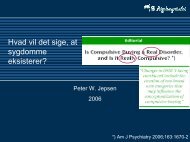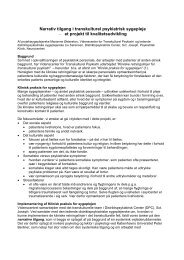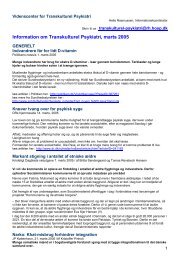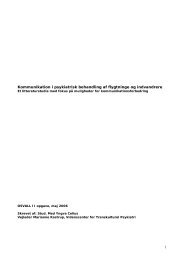Information om Transkulturel Psykiatri, marts 2009 - Videnscenter for ...
Information om Transkulturel Psykiatri, marts 2009 - Videnscenter for ...
Information om Transkulturel Psykiatri, marts 2009 - Videnscenter for ...
Create successful ePaper yourself
Turn your PDF publications into a flip-book with our unique Google optimized e-Paper software.
<strong>Videnscenter</strong> <strong>for</strong> <strong>Transkulturel</strong> <strong>Psykiatri</strong>. <strong>Psykiatri</strong>sk Center København<br />
Helle Rasmussen, <strong>In<strong>for</strong>mation</strong>skoordinator<br />
What is wrong with DSM IV and ICD-10? They are c<strong>om</strong>plex with too many chapters and numbers of<br />
disorders which increase sharply with each new edition, c<strong>om</strong>orbidity, excessive use made of "Not Otherwise<br />
Classified" (NOC), within category heterogeneity and no place <strong>for</strong> subthreshold disorders. Has the right<br />
nosologic system been c onceptualized? Are the right diagnostic categories and criteria being used? Has the<br />
diagnostic threshold been at the right level? Have the course and characteristics of disorders been correctly<br />
typified? Are existing diagnostic criteria being employed in an unbiased and culturally appropriate way? The<br />
goals of Psychiatric Classification are to bring ―order to chaos‖, to make research easier, to enable everyone<br />
to c<strong>om</strong>municate clearly, to help clinicians determine prognosis and treatment and to satisfy sociocultural<br />
demands placed on psychiatry. Currently five main groups of psychiatric disorders exist: 1) Neuro-cognitive<br />
disorders - disorders of cerebral tissue; 2) Developmental Disorders - failures of normal development; 3)<br />
Psychoses, loss of contact with reality; 4) Externalizing Disorders, low constraint, disinhibition; and, 5)<br />
Emotional Disorders – high neuroticism ("negative affect"). Those who are involved in DSM V and ICD-11<br />
are deliberating dimensions or spectra or clusters, e.g. cognitive, psychotic, mood or affective, obsessive,<br />
externalizing (substance abuse, personality disorders), internalizing (high neuroticism, e.g. anxiety,<br />
depression, panic, phobia), bodily disorders (eating, sleep and sexual). The addition to the categorical<br />
system of continuous, ―dimensional‖ measures into the various diagnostic d<strong>om</strong>ains might help resolve s<strong>om</strong>e<br />
of the critical taxon<strong>om</strong>ic issues currently facing the field of mental health, especially the subthreshold<br />
disorders.Diagnosis in diverse cultures has s<strong>om</strong>e caveats namely: disparities that may be the result of<br />
misdiagnosis or nondiagnosis due to unfamiliarity with the culturally determined pathoplastic c<strong>om</strong>ponents of<br />
any clinical entity, differences in measures employed to assess psychiatric disorders that can generate<br />
response biases, discrimination, racism, social position, and even expectations about services and treatment<br />
that may cloud the diagnostic process. Linguistic limitations on the patient's and the clinician's side produce a<br />
<strong>for</strong>midable (and obvious) c<strong>om</strong>munication obstacle. Diagnosis in psychiatry is meant to reflect individual<br />
coping styles on the one hand, and cust<strong>om</strong>ary treatment options on the other. Both factors are culturally<br />
charged and both are also parcels of the disparities field.<br />
Key Words: ICD-10 and ICD-11, DSM IV and DSM V, Arab perspective, Diagnostic Criteria, Categorical<br />
versus, Dimensional classifications<br />
Arab Journal of psychiatry 22(2), 89-94, 2011<br />
Læs artiklen her: http://www.arabjpsychiat.c<strong>om</strong>/media/PDF/2011_n/2011_nov.pdf<br />
Perceived neighborhood environment affecting physical and mental health : a study<br />
with Korean American older adults in New York City<br />
Roh, Soonhee; Jang, Yuri; Chiriboga, David A.; Kwag, Kyung Hwa; Cho, Sunhee; Bernstein, Kunsook<br />
This study examined how subjective perceptions of the neighborhood environment (e.g., perceived ethnic<br />
density, safety, social cohesion, and satisfaction) influenced the physical and mental health of Korean<br />
American older adults. Using data fr<strong>om</strong> 420 residents of the New York City metropolitan area (M age=71.6,<br />
SD=7.59), health perceptions and depressive sympt<strong>om</strong>s were estimated with hierarchical regression models<br />
entered in the order of (1) demographics and acculturation, (2) health-related variables, and (3) perceived<br />
neighborhood environment. After controlling <strong>for</strong> the effects of the individual-level variables, perceived<br />
neighborhood environment was found to make a significant contribution to both outc<strong>om</strong>es. Individuals less<br />
satisfied with their overall neighborhood environment were more likely to have negative perceptions of health<br />
and depressive sympt<strong>om</strong>s. A strong linkage between perceived neighborhood safety and depressive<br />
sympt<strong>om</strong>s was also observed. Findings fr<strong>om</strong> the study highlight the importance of subjective evaluations of<br />
neighborhood environment and provide implications <strong>for</strong> health pr<strong>om</strong>otion.<br />
Keywords Perceived neighborhood environment – Health - Korean American older adults<br />
Journal of immigrant and minority health 13(6), 1005-1012, 2011<br />
Predictive validity of a culturally in<strong>for</strong>med diagnosis of schizophrenia : A 30 month<br />
follow-up study with first episode psychosis<br />
Zandi, Tekleh; Havenaar, Johan M.; Limburg-Okken, Laan, Wijnand; Kahn, Rene S; van den Brink, Wim<br />
Abstract<br />
Previous research has shown discrepancies between a standard diagnostic interview <strong>for</strong> schizophrenia<br />
(CASH) and a culture sensitive version of this instrument (CASH-CS) in Moroccan patients. More specifically<br />
7






